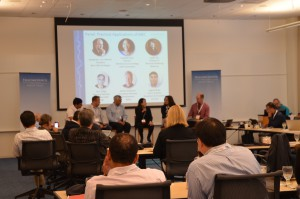Cloud Forum: Distributed Cloud & Mobile Edge Computing (MEC)
Telecom Council meets monthly for lunch with dozens of telcos, vendors, startups and VCs. Join Telecom Council members to discuss ETSI’s Mobile Edge Computing (MEC) initiative that puts cloud computing at the edge of the mobile network for ultra-low latency, high bandwidth and access to RAN information for enterprise users.
- Date:6/24/2016 12:00 PM
- Location Oracle, Redwood City CA (Map)
Description
Agenda, Attendee List and Presentations are available to members in the PRESENTATION LIBRARY
Silicon Valley, California, Jun 24, 2016/Meeting Recap/ Telecom Council member Oracle hosted our Cloud Forum meeting at their Redwood City headquarters–thank you, Oracle!
 Why Mobile Edge Computing (MEC) / Distributed Cloud?
Why Mobile Edge Computing (MEC) / Distributed Cloud?
Star topologies make sense, but can become bogged down as billions of devices connect and start to send chatty signaling data or payloads. The Internet has shown that replacing a star topology with a “star of stars” topology can better handle a surge of connected endpoints by keeping lots of traffic inside segments and LANs. MEC helps telecom networks achieve similar efficiencies.
MEC or Distributed Cloud has the ability to move compute power to the edge in telecom networks (much as it has in IT and data networks) in order to reside in unusual locations like:
- NFV Servers that can become other virtual servers (ex: media) as needs arise
- IoT M2M traffic
- Enterprise Small cell equipment to serve Cloud services more locally
- Stadium Small Cell Base Stations carrying video content within many stadium node
Moderator, Jon Metzler, President at Blue Field Strategies explored these and other considerations with our panelists:
- Intel Corporation: Caroline Chan, Director, Wireless Access Strategy
- Midokura: Susan Wu, Director of Technical Marketing
- AT&T: Tom Tofigh, Principal Member of Technical Staff
- Nokia: Marko Hokkanen, Ecosystem Business Development
- Ericsson: Yogesh Bhatt, Sr. Director, Ecosystem & Innovation
Distributed Cloud reduces latency and traffic through the core for information that actually remains mostly local. It allows the WWAN to compete more effectively with WLAN and other solutions.
NFV and SDN are powerful enablers of Distributed Cloud, since dedicated hardware will not need to be placed at the network edge in order to run edge servers. Virtual machines can be spun up and down as needed, and managed by a SDN. Distributed Cloud may start with some targeted services, but eventually even instantiations of the EPC (Evolved Packet Core) can be run at the edge, improving network resiliency, speed, and efficiency.
Networking standards have been around for three decades and were primarily driven by telecom Use Cases where faulty system failures would be too catastrophic to contemplate.
With Linux becoming the mainstream operating system for compute systems, now getting into networking systems, this causes the disaggregation of the network operating system from the networking gear (breaking up the proprietary black box implementation).
White boxes are built with off-the-shelf switching chips known as merchant silicon (from Broadcom and Intel), and loaded with open SDN software to run many networking applications.
Having Linux as the network OS changes the networking landscape, as new applications running on the Linux-enabled switch do not need an IETF standard to talk between each other, just like any application running on Linux on servers within the data center. That opens up the door for startups and non-traditional NEPs (like Dell or Lenovo, for example) to provide networking applications and solutions into the telecom market.
This can be a bit unsettling for traditional Network Equipment Providers (NEPs).
Just to add on the application development side, networking applications are now developed on tried and true open source components and containerization. Using agile software development, the rate of which these applications are coming to market is far faster than the traditional waterfall methods. So the combination of the networking applications and the disaggregation of the traditional black box implementation makes it possible to see software-based network innovation that weren’t seen in the last two decades.
This is tantamount to a whole new world order for networking.
Agenda, Attendee List and Presentations are available to members in the PRESENTATION LIBRARY